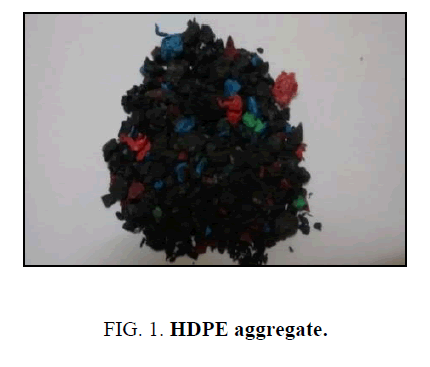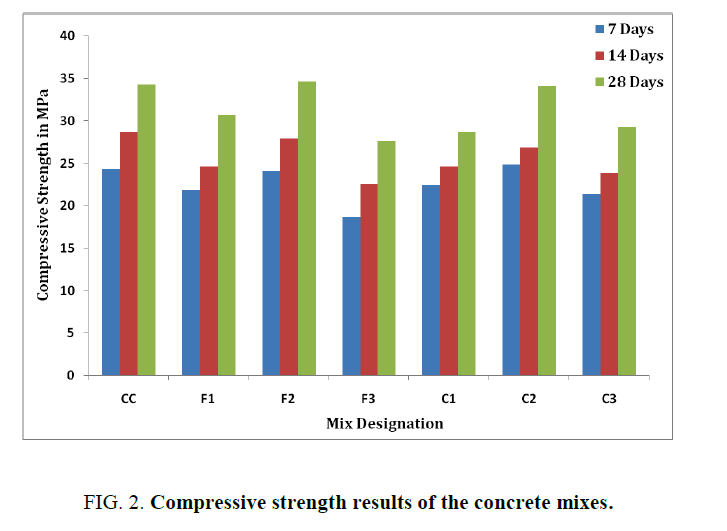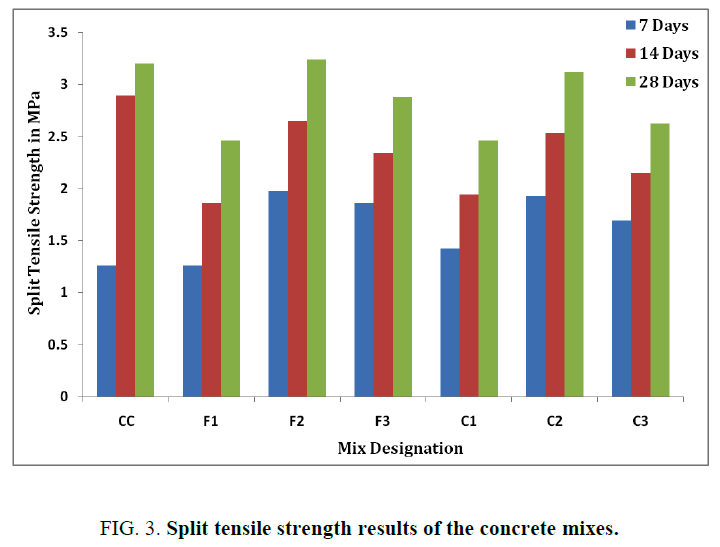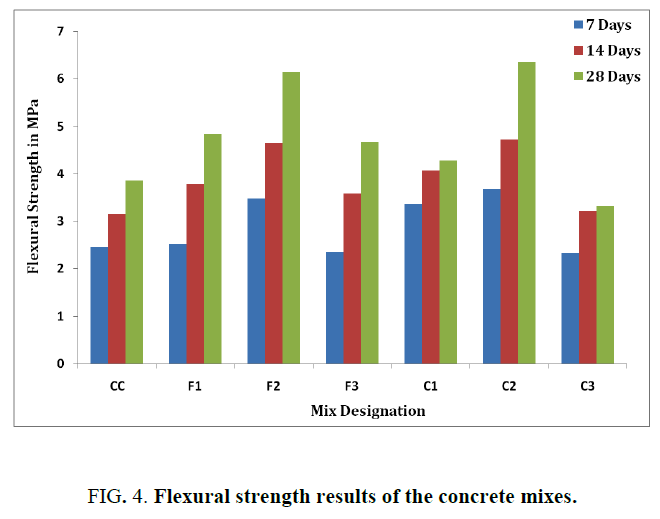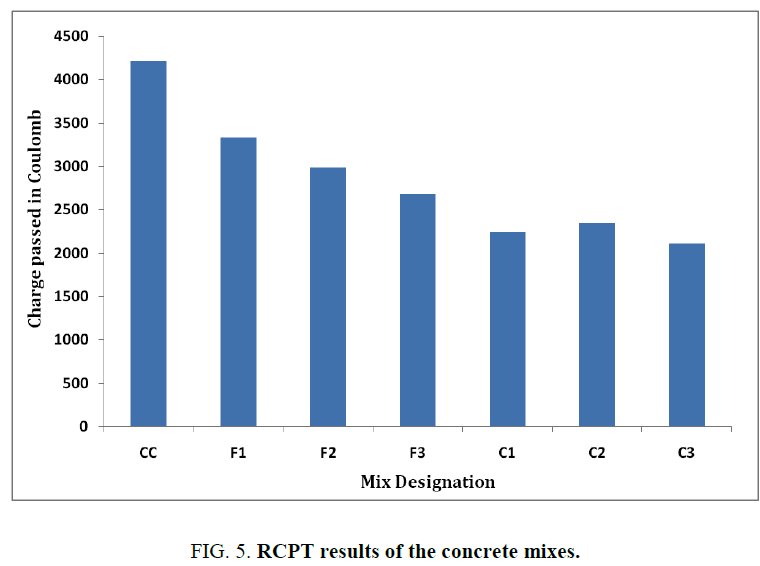Original Article
, Volume: 15( 1)Strength and Chloride Permeable Properties of Concrete with High Density Polyethylene Wastes
- *Correspondence:
- Shanmugapriya M, Department of Chemistry, Department of Civil Engineering, Sathyabama University, Chennai, Tamil Nadu, India, Tel: 9840651354; E-mail: priyadhakshith1407@gmail.com
Received: March 03, 2017; Accepted: March 14, 2017; Published: March 17, 2017
Citation: Shanmugapriya M, Helen Santhi M. Strength and Chloride Permeable Properties of Concrete with High Density Polyethylene Waste. Int J Chem Sci 2017;15(1):108.
Abstract
The present study investigates the mechanical and chloride permeable properties of concrete with fine and coarse aggregates have been partially replaced with high density poly ethylene (HDPE) waste. Totally six different concrete mixes of M25 grade were designed with partial replacement of fine aggregate by 5% ,10%, 15% and coarse aggregate by 10%, 15%, 20% with HDPE waste. The strength and durability properties such as compressive strength, flexural strength, split tensile strength and rapid chloride ion penetration of concrete with HDPE specimens were conducted and the tests results were compared with the control concrete.
Keywords
HDPE; Aggregates; Mechanical properties; Rapid chloride penetration
Introduction
In order to improve the long term performance of concrete, innovative chemical admixtures and supplementary materials can be added [1], which are majorly the industrials by-products such as fly ash [2], foundry sand [3,4], waste tyre [5,6], recycled aggregates [7,8], waste plastics [8-14] and so on. The use of these by-products not only enhances the properties of concrete and resource efficiency, it also increases the sustainability of materials which is unavoidable in current scenario.
The disposal of waste plastics causes health issues in humans in addition to environmental effects. A serious of pollution problems are caused by non-recycling of waste materials and these environmental and health issues can be greatly reduced by effectively employing the waste disposed plastics in the production of concrete. An effort has been made to detail a systematic study of compressive strength of concrete with various proportions of E-waste as coarse aggregate in concrete [9]. Various percentage of replacement of plastic was used as an alternate in aggregate to find the strength of concrete was conducted [10,11] and would solve the scarcity in fine aggregate and disposal of waste plastic was studied [12,13].
The relationship between splitting tensile strength and flexural strength with the compressive strength of concrete containing waste PET as fine aggregates replacement has been assessed by Juki et al. [14]. Recycling of e-plastic not only helps in reducing in cost of cement concrete but also has numerous indirect benefits like reduction in land fill cost, reducing in air pollution due to incineration. Plastic are used in our today life style for packaging, serving, and even disposing. With the industrial uprising, heap manufacture of goods started and plastic seem to be cheaper and valuable raw material of plastic [15,16]. Hence the concrete experts recommend plastic as an alternative material in the construction industry.
In this regard, an experimental investigation was carried out to study the effective utilization of plastic and the properties of concrete by partial replacement of fine aggregate by 5%, 10%, 15% and coarse aggregate by 10%, 15%, 20% with high density polyethylene (HDPE) and comparing the result analysis with conventional concrete of similar grade.
Experimental
Materials
The basic properties of various materials such as cement, sand, coarse aggregates and plastic wastes (HDPE) was carried out as per the IS Code. The Ordinary Portland Cement of 43 grade conforming to IS 8112 was used. The specific gravity of Ordinary Portland cement is 3.15. The properties of natural river sand and HDPE aggregate (Figure. 1) were determined by various tests as per IS 2386 for fine aggregate.
The properties of locally obtained crushed granite stones were determined by conducting test as per IS 2386 and the maximum size of aggregate used was 12.5 mm and specific gravity was 2.62. The properties of the aggregates used in the work are detailed in Table 1.
| Properties | Coarse Aggregate | Sand | HDPE |
|---|---|---|---|
| Specific Gravity | 2.62 | 2.55 | 2.95 (apparent) |
| Fineness Modulus | 3.18 | 3.86 | 2.98 |
| Water Absorption (%) | 0.5 | 1.69 | 0 |
| Bulk density (kg/m3) | 1623 | 1679.6 | - |
Table 1: Properties of aggregates.
Mix proportioning of concrete
The concrete mixes were prepared in accordance with IS 10262 for a characteristic compressive strength of 25 MPa. The concrete mixes were prepared with replacing the fine aggregate (5%, 10% and 15%) and coarse aggregate (10%, 15% and 20%) by HDPE waste. The control mix was prepared with conventional cement concrete and the detailed mix proportion of the mixes is given in Table 2 with a constant water-cement ratio of 0.42.
| Mix Designation | Quantity in kg/m3 | |||
|---|---|---|---|---|
| Cement | Fine aggregate | Coarse aggregate | HDPE | |
| CC | 320 | 848.6 | 1286.5 | 0 |
| F1 | 320 | 806.2 | 1286.5 | 42.4 |
| F2 | 320 | 763.8 | 1286.5 | 84.8 |
| F3 | 320 | 721.3 | 1286.5 | 127.3 |
| C1 | 320 | 848.6 | 1157.86 | 128.68 |
| C2 | 320 | 848.6 | 1093.55 | 192.99 |
| C3 | 320 | 848.6 | 1029.23 | 257.308 |
Table 2: Details of mix proportion.
Methodology
The mechanical properties of the concrete mixes were assessed in the form of compressive strength, split tensile strength and flexural strength; and the chloride permeability was measured using rapid chloride penetration test (RCPT). The compressive strength of the mixes were assessed using concrete cubes of 150 mm × 150 mm × 150 mm size at the age of 7, 14 and 28 days of curing in accordance to IS 516. The split tensile strength of the mixes was tested in accordance to IS 5816 using concrete cylinders of size 150 mm × 300 mm at the age of 7, 14 and 28 days curing. Flexural strength of the concrete mixes was evaluated using prismatic specimens of size 500 mm × 100 mm × 100 mm as per IS 516 at the age of 7, 14 and 28 days of curing, with the aid of 1000 kN capacity universal testing machine (UTM) by subjecting the concrete specimens under four-point loading. The chloride ion penetration of concrete can be assessed either by RCPT test as per ASTM C1202 or salt ponding test as per AASHTO T259, where salt ponding test is considered to be time consuming [17]. Rapid Chloride Penetration Test (RCPT) on concrete is done mainly to estimate the amount of corrosion of concrete due to chloride ion in concrete. In this investigation work, cylindrical concrete specimens of size 100 mm × 50 mm discs were casted and cured for 28 days in chloride free water and the test was carried out in accordance to ASTM C1202.
Results and Discussion
Compressive strength
The compressive strength results variation of the concrete mixes with the variation in the mass of HDPE is shown in Figure. 2. It has been observed from the test results that 71.2%, 69.6 and 67.5% of its 28 days strength were observed for 7 days compressive strength for the mixes with 5%, 10% and 15% replacement of sand with HDPE waste respectively. The values were found to reduce with the increase in the volume of sand replacement. Whereas, in the case of coarse aggregate replacement this was observed to be 78.3%, 72.8% and 73.0% respectively for the mixes with 10%, 15% and 20% replacement with HDPE waste. Similar observation was made in the case of 14 days, where the results were found to be in the range of 80.1% to 85.7% of its 28 days compressive strength results. The 28 days compressive strength of the mixes with 10% replacement level of sand and 15% replacement level of coarse aggregate shows a comparable results with that of the conventional cement concrete mix. The reason for the reduction in the compressive strength with the increase in the HDPE waste may be attributed to the reduction in the unit weight of the concrete mixes with the increase in the HDPE waste volume [18]. The reduction may also be attributed to the very low bond strength between the paste and the surface of the plastic, as well as the hydrophobic nature of the plastic, where the hydration of cement can be inhibited by restricting the movement of water [19].
Figure 2: Compressive strength results of the concrete mixes.
Split tensile strength
The variation in the split tensile strength of the concrete mixes at the age of 28 days curing is shown in Figure. 3. From the results, it has been observed that the 7 days results were found to be more than the conventional cement concrete mixes and this proportion increases with the increase in the HDPE waste content. The improved performance may be associated with the ductile property of the HDPE waste.
Figure 3: Split tensile strength results of the concrete mixes.
The maximum tensile strength of the concrete specimens with HDPE aggregates was inferred due to plastic fibers which trap the cracks and shows better results than conventional concrete [20]. The reduction in the split tensile strength of the concrete mixes with increasing volume of HDPE waste is mainly due to the weaker bond between the smoother surface of the plastic waste and cement paste due to the free water available at the surface of the plastic.
Flexural strength
The variation in the flexural strength of the concrete mixes at the age of 7, 14 and 28 days curing is shown in Figure. 4. It has been observed from the test results that the mixes with partial replacement of aggregates with HDPE waste shows superior performance in the flexural strength compared to the conventional cement concrete mix irrespective of the volume of replacement and age of curing. The 28 days flexural strength was found to be maximum for the mixes with 10% replacement of sand (6.14 MPa) and 15% replacement of coarse aggregate (6.34 MPa) compared to conventional cement concrete mix (3.86 MPa).
Figure 4: Flexural strength results of the concrete mixes.
Rapid chloride penetration test (RCPT)
Corrosion in reinforced concrete structures is a severe crisis which seeks a widespread attention in recent years. The most common deterioration of concrete structure is due to corrosion of reinforcing steel mainly because of chloride ingress. Table 3 shows the standard value for chloride iron penetration as per ASTM C1202. The RCPT results of the concrete mixes tested at the age of 28 days curing is shown in Figure. 5. From the figure, it can be observed that the chloride ion penetration is getting reduced and lies in the moderate level of 2000-4000 coulombs while adding High density polyethylene waste in concrete either as fine or coarse aggregate.
Figure 5: RCPT results of the concrete mixes.
| Charge passed (coulombs) | Chloride Ion Penetrability |
|---|---|
| >4000 | High |
| 2000-4000 | Moderate |
| 1000-2000 | Low |
| 100-1000 | Very low |
| <100 | Negligible |
Table 3: Standard RCPT values as per ASTM C 1202.
The reduced chloride ion penetration with the increasing replacement of natural aggregates with HDPE waste is mainly due to the impervious HDPE granules which blocks the passage of chloride ion into concrete. Similar observation was made by Kou et al. [20]. It can be suggested for the construction of road and low load bearing structures in coastal area where more corrosion is anticipated.
Conclusion
The compressive and split tensile strength of the concrete mixes with varying replacement level of natural aggregates with HDPE waste shows a similar behaviour than that of the conventional cement concrete mix. Whereas the flexural strength properties of the mixes with the incorporation of HDPE waste, shows superior performance than conventional cement concrete mix. The rapid chloride permeability result infers that the chloride ion ingression reduces with the incorporation of HDPE waste and the mixes were categorized under moderate permeability compared to cement concrete of high permeability. The study shows that the waste plastic can be reused in concrete as an alternate for aggregates which will reduce considerably the disposal problems.
The lightweight concrete using HDPE replacement can be found suitable in application of non-bearing lightweight concrete. The partial replacement of aggregate with plastic can reduce the overall unit weight of the concrete substantially. The plastic do not corrode, it is lighter than steel fibers and better control of the plastic shrinkage cracking.
References
- Papadakis VG, Tsimas S. Supplementary cementing materials in concrete part 1: Efficiency and design.CemConcr Res. 2002;32:1525-32.
- Rajamane NP, Annie Peter J, Ambily PS. Prediction of compressive strength of concrete with fly ash as sand replacement material.CemConcr Comp. 2007;29:218.
- Singh G, Siddique R. Effect of waste foundry sand (WFS) as partial replacement of sand on the strength, ultrasonic pulse velocity and permeability of concrete.Constr Build Mater. 2012;26:416.
- Ganesh Prabhu G, Hyun JH, Kim YY. Effects of foundry sand as a fine aggregate in concrete production.Constr Build Mater. 2014;70:514.
- Bravo M, de Brito J.Concrete made with used tyre aggregate: Durability-related performance.Cleaner Prod J. 2012;25:42.
- Pacheco-Torgal F, Ding Y, Jalali S. Properties and durability of concrete containing polymeric wastes (tyre rubber and polyethylene terephthalate bottles): An overview.Constr Build Mater. 2012;30:714-24.
- Kathirvel P, Kaliyaperumal SRM. Influence of recycled concrete aggregates on the flexural properties of reinforced alkali activated slag concrete.Constr Build Mater. 2016;102:51-8.
- Arulrajah A, Disfani MM, Haghighi H, et al. Adding ground sand to decrease paste volume, increase cohesiveness and improve passing ability of SCC.Constr Build Mater. 2015;84:46-54.
- Lakshmi R, Nagan S. Studies on concrete containing E-plastic waste.Int J Environ Sci. 2010;1:270.
- Ismail ZZ, Enas A, Hashmi AL. Waste plastic in concrete mixture as aggregate replacement.Waste Manage. 2008;28:2041-7.
- Consoli NC, Montardo JP, Prietto PDM, et al.Engineering behavior of sand reinforced with plastic waste.Engineering behavior of sand reinforced with plastic waste.J Geotechnical Geoenvironmental Eng. 2002;128:462-72.
- Kathe V, Gangurde A, Pawar A. Green concrete using plastic waste.Int J Eng Trends Technol. 2015;19:214.
- Suganthy P, Chandrasekhar D, Sathish Kumar PK. Utilization of pulverized plastic in cement concrete as fine aggregate.Int J Res Eng Technol. 2013;2:1015-9.
- Juki MI, Awang M, Mahamad MKA, et al. Relationship between compressive, splitting tensile and flexural strength of concrete containing granulated waste polyethylene terephthalate (PET) bottles as fine aggregate.Adv Mater Res. 2013;795:356.
- Batayneh M, Marie I, Asi I. Use of selected waste materials in concrete mixes.Waste Manage. 2006;27:1870-6.
- Bayasi Z, Zeng J. Properties of polypropylene fiber reinforced concrete.ACI Mater J. 1993;90:605-10.
- Krishnakumar K, Bhaskar S, Parthiban K. Evaluation of chloride penetration in OPC Concrete by silver nitrate solution spray method.Int J ChemTech Res. 2014;6:2676.
- Saikia N, de Brito J.Use of plastic waste as aggregate in cement mortar and concrete preparation: A review.Constru Build Mater. 2012;34:385.
- Foti D. Preliminary analysis of concrete reinforced with waste bottles PET fibers.Constru Build Mater. 2011;25:1906-15.
- Kou SC, Lee G, Poon CS, et al. Properties of lightweight aggregate concrete prepared with PVC granules derived from scraped PVC pipes.Waste manage. 2009;29:621.
